
Page 80: of Offshore Engineer Magazine (Aug/Sep 2014)
Read this page in Pdf, Flash or Html5 edition of Aug/Sep 2014 Offshore Engineer Magazine
between the state program and the opera- tor that own the structure. Any one of those puzzle pieces could make or break the reefng of a structure,” Peter says. “There’s a lot of intricacies to this, so not
EyebrowProduction every structure is suitable. It also requires buy-in from the operator that owns the structure because it’s ultimately their decision whether they want to participate in the state program. The state program has to accept liability of the structure that’s actually being reefed.”
BSEE’s Rigs to Reefs program evaluates suitability, and then turns it over to the state program to cooperate on fnal place- ment. The size of the reefng area varies, with Peters offering the examples of an average size of a reef site off Texas being around 40 acres, while Louisiana’s aver- age reef sites are around 360 acres.
Site composition also varies. Dale
Shively, artifcial reef program leader for Texas Parks and Wildlife Dept. says there are many options at the program’s disposal. “Sometimes we can present scenarios where it works out better than [the companies] originally thought,” he explains, urging companies not to be “closed-minded” when looking at disposal options. “We can work with the US Army Corps of Engineers and the US Coast Guard to see if a shallower clearance is available... We can perform a partial removal, in which the platform
Reef site High Island (HI) 376A. HI is base stays in place on the ocean bottom one of 18 existing Rigs to Reefs sites with the top next to it; topple it in place; along Texas’ coasts. Photo from Chris Ledford /
Texas Parks and Wildlife Dept. Artifcial Reef Program..
or tow the platform to an existing reef site.” coordinator for BSEE, explains. While there are copious structures As far as permitting is concerned for
Among the Act’s fndings were that ribboning the Gulf’s waters, not all of reefng programs, Broussard says that, “US fshery production annually falls them make the cut for a federal or state “only a few components on the permit short of satisfying US demand,” and that reefng program. Peter places the number are different. We want to ensure that the “properly designed, constructed, and of structures reefed to date in the Gulf of facility or jacket assembly is compatible located artifcial reefs in waters covered Mexico at 455. with the program and won’t introduce under this title can enhance the habitat There are a lot of single-pile caissons any additional impacts or issues when and diversity of fshery resources.” and structures in shallow water in the it comes to the OCS. We don’t want it
This act “prompted the states to Gulf of Mexico that would automati- to break loose and damage infrastruc- develop for artifcial reefs programs,” cally be disqualifed from Rigs to Reefs ture, and we don’t want it to have any
Peter says. “The MMS followed suit on size alone. While the Gulf of Mexico contaminants.” shortly thereafter and allowed departures is known for its deepwater, the US EPA Peter points out that these facilities from the normal removal of platform after says that the waters of the continental can sometime offer the marine life more their use of extracting oil and gas.” slope are just 200-300m. Rigs to Reefs than Mother Nature herself: the reefed
After some trial structures were towed also generally requires a three-pile structures offer high relief, meaning that to Florida for reefng between 1982 and structure at minimum. If a structure is they extend further in the water column 1983, Rigs to Reefs was formalized as a in an area with other confict uses, it also than the natural structures. program in 1985. The two states with would not be able to be reefed. “There’s quite an ecosystem that devel- the majority of structures in their waters
Just like the reefs themselves, the ops around some of these structures,” created programs frst: Louisiana’s state process is a delicate one, where a missing Peter says. “They provide stable, durable, program began in 1986, with Texas fol- piece could cause the entire process to complex habitats that allow things to lowing in 1990. The other states that crumble. “There are a number of things thrive that wouldn’t be there because of channel into the Gulf of Mexico also that actually determine if a structure is the sand and mud bottom in the bottom started programs throughout the 1990s. suitable, and there are also the dealings of the Gulf.”
August 2014 | OE oedigital.com 82 080_OE0814_ProdOps1_Rigs-to-Reefs.indd 82 7/22/14 10:15 PM

 79
79

 81
81